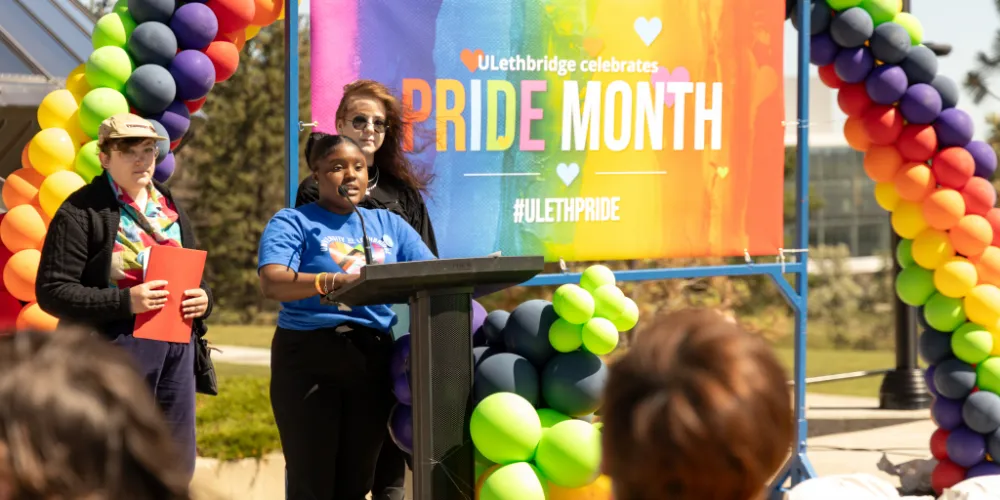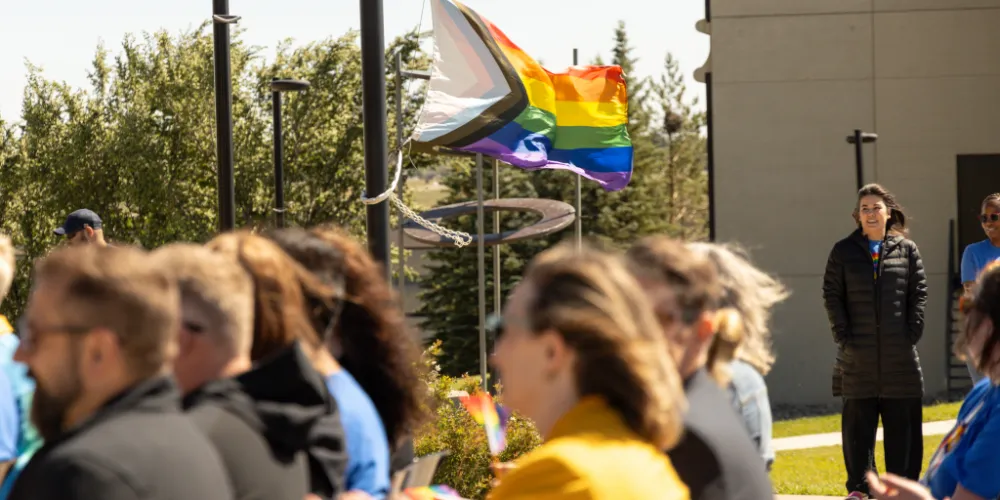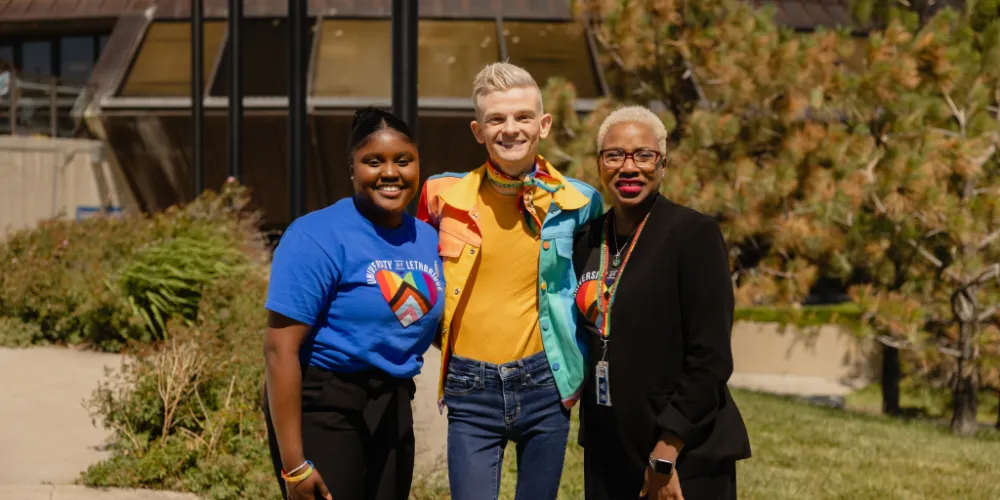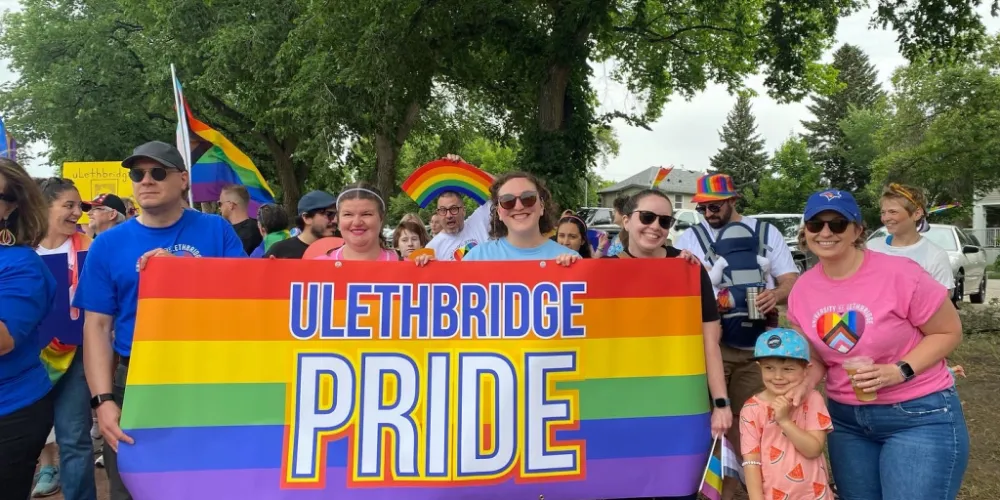2SLGBTQ+ Resources
The University is working toward creating a learning and working environment free of biphobia, homophobia and transphobia, where 2SLGBTQ+ people (students, staff, faculty) can thrive.
Campus Safety
Campus Security website
403-329-2345
911 for police, fire, or ambulance
Commissioner of Oaths (free) Pending
Contact Natasha Buis Deering
Executive Director, Strategic Enrolment & Registrar
Student Enrolment and Registrar’s Services website
ECM Chaplain
Student groups and peer-led support services
Campus Collective Centre
The Campus Collective Centre (CCC) is a student-led and student-run space and resource hub located in the SU Building (SP150 – First floor, by the tunnel) that works to offer resources and supports to students and the community. The CCC offers free sexual and menstrual health resources – such as condoms, menstrual products, pregnancy tests and quick-result HIV tests. It also provides support in accessing resources focused on housing and food insecurity, physical and mental health, and overall well-being and stability. The CCC team is passionate about advocating and working to create change while also supporting our campus community. They aim to foster an environment wherein individuals may seek empowerment, guidance and resources while feeling recognized and validated.
Q-Space
Q-Space provides a community and space for the 2SLGBTQ+ community at the University of Lethbridge. Q-Space works to foster respect, inclusion and justice for the 2SLGBTQ+ community. We work towards making the University of Lethbridge an inclusive and queer-affirming place for all members of the campus community through our political work.
Get in touch:
✉️ qspace@uleth.ca
![]() Facebook
Facebook
![]() Instagram
Instagram
![]() Discord
Discord
University of Lethbridge name change procedures
Skipping Stone provides guidance about name and gender marker ID change processes in Alberta
Legal name change
Legal name change form (PDF)
Current and former students can request a change to their legal name on University documents. Complete and send the form linked above by email to regoffice@uleth.ca or drop it off in person at the Student Enrolment and Registrar Services office (SU140) or the Calgary Campus Office (S6032).
You’ll also need to supply official documentation of your legal name change to support your request. See the form for a list of official documentation options, and how to guarantee your official documentation if submitting this form by email.
Preferred first name update
Current students can request to have their chosen first name added to their student records. This allows a non-legal first name that you choose to be displayed in University systems such as email, Moodle, Zoom, and Office 365. Adding a chosen first name does not replace your legal first name on official ULethbridge records and documents. To add your chosen first name, fill out the form here. You’ll receive a confirmation email when the change is complete.
Research (Examples)
Visit the University of Lethbridge Library website for more resources
Academic programs and faculty research
- Dr. Paul Vasey and the members of his lab conduct cross-species and cross-cultural research on non-conceptive sexuality.
- Dr. Suzanne Lenon, website, Teaching Beyond the Gender Binary: A Resource Manual
- Gender and Population Studies (GAPS) in Health
- The GSA difference: LGBTQ and ally experiences in high schools with and without gay-straight alliances, Tina Fetner, Athena Elafros
- TRANS-forming Rural Primary Care Project: Exploring the Inclusivity and Safety of Rural Primary Care Spaces for Trans-persons in Southern Alberta, Peter Kellett, Lisa Howard, Julia Brassolotto
- Teaching Beyond the Gender Binary, Susan Lenon, Kathryn Delucia-Burk, Stefanie Desroches
- Women and Gender Studies Department, University of Lethbridge
Journals of interest
- Canadian Online Journal of Queer Studies in Education
- GLQ: A Journal of Lesbian and Gay Studies
- Journal of Bisexuality
- Journal of Canadian Studies - Vol 54 (2-3), Spring-Fall 2020 Special Issue on Queer Canada
- Journal of Lesbian Studies
- Journal of the History of Sexuality
- QED: A Journal in GLBTQ Worldmaking
- Sexualities
- Social Text - 38(4), December 2020 Special Issue Left of Queer
- Transgender Studies Quarterly
Research databases
- Gender Studies Database (GSD). Access gender-related literature covering sexual diversity issues, indexes, journals, conference papers, books, book chapters, government reports, discussion and working papers, theses & dissertations and other sources. EBSCO.
Additional Research (Canadian and International)
Washrooms:
PE 0W1 - Level 0, across from PE 020 & PE 040 (classrooms)
PE 1W3 – Level 1, in the hallway across from PE 110 & offices
PE 2W3 – Level 2, in the Northeast corner of the Indoor Track
Changing Rooms:
PE 185F – Level 1, past CSC gates toward Pool access
PE 185A-E, 5 gender-neutral change rooms (w/shower in each)
WE00W1
AHW01
AHW03
AV1W01
EP10W3
EP11W1
EP11W2
DC1W01
DC1W02
DC1W03
DC1W04
HH1W03
L9W6
L9W5
(Across from Starbucks)
SC12W1
Multiple private stalls, all-gender washroom:
9th level
- SA9W001 (10 stalls)
Single stall:
6th level
- SA6W101
- SA6W102
- SA6W103
- SA6W104
- SA6W105
- SA6W106
7th level
- SA7W004A
- SA7W008
- SA7W201
- SA7W202
- SA7W302
8th Level
- SA8W101
- SA8W102
- SA8W201
- SA8W202
- SA8W301
- SA8W302
- SA8W401
- SA8W402
9th Level
- SA9W101
- SA9W102
- SA9W201
- SA9W202
- SA9W301
- SA9W302
- SA9W401
- SA9W402
SS100W1
SS1W3
SS1W4
ST100W1
ST110W1
ST120W1
ST130W1
ST140W1
SU0W10
SU0W20
SU0W52
SU0W54
TH2W5
Level 4
W4W31
W4W32
W4W33
W4W34
W4W35
W4W36
W4W64
Level 6
W6W60
Level 6, Section E
E6W1
Level 7, Section A, Across from the Equity, Diversity and Inclusion Office
A7W4
Level 8, All Washrooms
Calgary
- Calgary Gay History
- Calgary Pride
- Centre for Sexuality
- Outlink, Calgary's Centre for Gender and Sexual Diversity
- Queer & Trans Health Collective
- Queer Youth Of Colour – Mohkinstsis/Calgary
- The Alex Youth Health Centre
- Transgender/Gay/Lesbian/Bisexual Allied Therapists in Calgary
- True Colours Calgary
Edmonton
Educational resources
Gender identity and gender expression
Alberta Human Rights Act
Gender, Gender Expression, Gender Identity, and Sexual Orientation are protected grounds under the Alberta Human Rights Act.
The following descriptions are quoted from the Protected areas and grounds under the Alberta Human Rights Act information sheet, which is based on Alberta Human Rights Act.
Gender is the state of being male, female, transgender or two-spirited. The ground of gender also includes pregnancy and sexual harassment.
Gender expression refers to the varied ways in which a person expresses their gender, which can include a combination of dress, demeanour, social behaviour and other factors.
Gender identity refers to a person’s internal, individual experience of gender, which may not coincide with the sex assigned to them at birth. A person may have a sense of being a woman, a man, both, or neither. Gender identity is not the same as sexual orientation, which is also protected under the Alberta Human Rights Act.
This ground includes protection from differential treatment based on a person’s actual or presumed sexual orientation, whether gay, lesbian, heterosexual, bisexual or asexual.
Practicing respectful language
Words have the power to promote inclusion, but can also be harming or traumatizing when not used with sensitivity. Language is inclusive if it conveys respect by actively valuing diversity and avoiding the exclusion or marginalization of others.
We offer the following tips for practicing inclusion:
Use the ‘preferred first name’ of people at all times, not their legal name. For example, if both appear on a class list, always use the preferred first name.
Do not make assumptions about a person’s gender or gender identity or refer to them in ways that reference an assumption about their gender or gender identity.
When referring to gender identity it is important to be aware of, and use ‘all-gender’ terms and phrasings. All-gender terms and phrasings are language free of explicit or implicit reference to gender or sex.
Examples include addressing one’s class by the non-gendered terms:
- “Students” or “class” rather than “Ladies and gentlemen”
- Using “machine-made” rather than “man-made”
- “Staff the front desk” rather than “man the front desk”
Pronouns
Address people by the pronouns they indicate. Students, staff and faculty may choose to be known by pronouns that are non-gendered or gender-neutral, such as they/them, rather than he/him or she/her. Invite (but don’t require) people to provide their pronouns. Referring to people by their pronouns conveys respect and inclusion.
The following are useful resources to learn more about using pronouns:
Gender Pronouns and Teaching- University of Waterloo
Pronouns and Cultures of Respect - University of Alberta, Q&A with Dr. Tommy Mayberry (Executive Director, Centre for Teaching and Learning at the U of A), about using gender pronouns and creating inclusive campus spaces.
Ruberg, Bonnie “Beaux.” “Helpful, Friendly, They/Them Pronoun Info Sheet for Inclusive Workplaces & Communities.” USC and UC Irvine, April 2017. (PDF)
The University of Lethbridge wishes to acknowledge the University of Waterloo and York University for permitting the use of materials from their respective websites.
Additional resources:
The Harm of Using ‘Dead Names’ - Queer Café, an excellent resource on the harms of deadnaming
This is What Gender Non-binary People Look Like - online publication Them interviews various people about their experiences being non-binary
100 Easy Ways to Make the World Better for Trans People - Vice article




